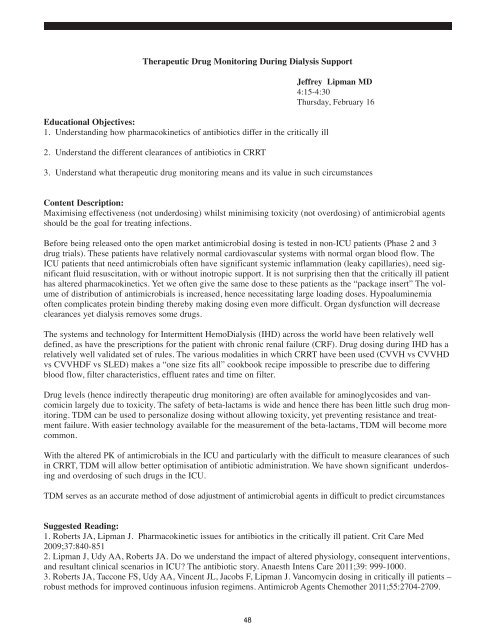ABSTRACTS from 16th International COnference on ... - CRRT Online
ABSTRACTS from 16th International COnference on ... - CRRT Online
ABSTRACTS from 16th International COnference on ... - CRRT Online
You also want an ePaper? Increase the reach of your titles
YUMPU automatically turns print PDFs into web optimized ePapers that Google loves.
Therapeutic Drug M<strong>on</strong>itoring During Dialysis Support<br />
Educati<strong>on</strong>al Objectives:<br />
1. Understanding how pharmacokinetics of antibiotics differ in the critically ill<br />
2. Understand the different clearances of antibiotics in <strong>CRRT</strong><br />
Jeffrey Lipman MD<br />
4:15-4:30<br />
Thursday, February 16<br />
3. Understand what therapeutic drug m<strong>on</strong>itoring means and its value in such circumstances<br />
C<strong>on</strong>tent Descripti<strong>on</strong>:<br />
Maximising effectiveness (not underdosing) whilst minimising toxicity (not overdosing) of antimicrobial agents<br />
should be the goal for treating infecti<strong>on</strong>s.<br />
Before being released <strong>on</strong>to the open market antimicrobial dosing is tested in n<strong>on</strong>-ICU patients (Phase 2 and 3<br />
drug trials). These patients have relatively normal cardiovascular systems with normal organ blood flow. The<br />
ICU patients that need antimicrobials often have significant systemic inflammati<strong>on</strong> (leaky capillaries), need significant<br />
fluid resuscitati<strong>on</strong>, with or without inotropic support. It is not surprising then that the critically ill patient<br />
has altered pharmacokinetics. Yet we often give the same dose to these patients as the “package insert” The volume<br />
of distributi<strong>on</strong> of antimicrobials is increased, hence necessitating large loading doses. Hypoaluminemia<br />
often complicates protein binding thereby making dosing even more difficult. Organ dysfuncti<strong>on</strong> will decrease<br />
clearances yet dialysis removes some drugs.<br />
The systems and technology for Intermittent HemoDialysis (IHD) across the world have been relatively well<br />
defined, as have the prescripti<strong>on</strong>s for the patient with chr<strong>on</strong>ic renal failure (CRF). Drug dosing during IHD has a<br />
relatively well validated set of rules. The various modalities in which <strong>CRRT</strong> have been used (CVVH vs CVVHD<br />
vs CVVHDF vs SLED) makes a “<strong>on</strong>e size fits all” cookbook recipe impossible to prescribe due to differing<br />
blood flow, filter characteristics, effluent rates and time <strong>on</strong> filter.<br />
Drug levels (hence indirectly therapeutic drug m<strong>on</strong>itoring) are often available for aminoglycosides and vancomicin<br />
largely due to toxicity. The safety of beta-lactams is wide and hence there has been little such drug m<strong>on</strong>itoring.<br />
TDM can be used to pers<strong>on</strong>alize dosing without allowing toxicity, yet preventing resistance and treatment<br />
failure. With easier technology available for the measurement of the beta-lactams, TDM will become more<br />
comm<strong>on</strong>.<br />
With the altered PK of antimicrobials in the ICU and particularly with the difficult to measure clearances of such<br />
in <strong>CRRT</strong>, TDM will allow better optimisati<strong>on</strong> of antibiotic administrati<strong>on</strong>. We have shown significant underdosing<br />
and overdosing of such drugs in the ICU.<br />
TDM serves as an accurate method of dose adjustment of antimicrobial agents in difficult to predict circumstances<br />
Suggested Reading:<br />
1. Roberts JA, Lipman J. Pharmacokinetic issues for antibiotics in the critically ill patient. Crit Care Med<br />
2009;37:840-851<br />
2. Lipman J, Udy AA, Roberts JA. Do we understand the impact of altered physiology, c<strong>on</strong>sequent interventi<strong>on</strong>s,<br />
and resultant clinical scenarios in ICU? The antibiotic story. Anaesth Intens Care 2011;39: 999-1000.<br />
3. Roberts JA, Tacc<strong>on</strong>e FS, Udy AA, Vincent JL, Jacobs F, Lipman J. Vancomycin dosing in critically ill patients –<br />
robust methods for improved c<strong>on</strong>tinuous infusi<strong>on</strong> regimens. Antimicrob Agents Chemother 2011;55:2704-2709.<br />
48
















